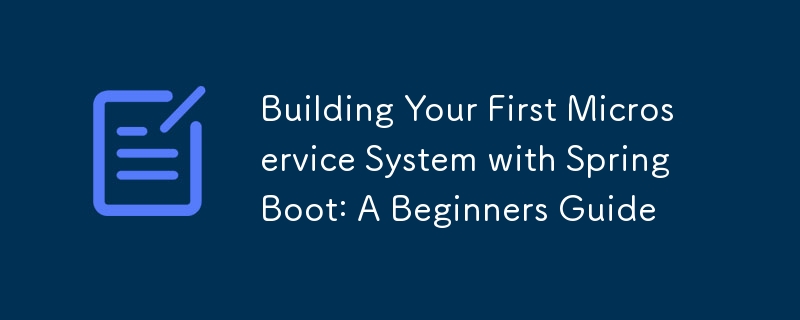

In diesem Leitfaden gehen wir Schritt für Schritt durch die Erstellung eines einfachen, aber umfassenden Microservices-Systems mit Spring Boot. Wir behandeln die Grundlagen von Microservices, richten die erforderliche Umgebung ein und implementieren zwei Microservices: OrderService und InventoryService. Darüber hinaus integrieren wir die Serviceerkennung mithilfe von Eureka und einem API-Gateway, um das Routing zwischen den Services zu verwalten.
Microservices sind ein Softwarearchitekturstil, bei dem eine Anwendung als Sammlung kleiner, unabhängiger Dienste erstellt wird, die zusammenarbeiten. Jeder Dienst ist in sich geschlossen und kommuniziert über klar definierte APIs mit anderen, wodurch das System flexibler, skalierbarer und einfacher zu verwalten ist.
Die Architektur unseres Systems wird aus zwei Microservices bestehen: OrderService und InventoryService. Der OrderService verwendet eine relationale Datenbank (MySQL) zum Speichern von Bestelldetails, während der InventoryService eine NoSQL-Datenbank (MongoDB) zum Verwalten von Bestandsdaten verwendet. Wir werden auch Service Discovery mit Eureka implementieren und ein API-Gateway für die Weiterleitung von Anfragen verwenden.
Bevor wir beginnen, stellen Sie sicher, dass Sie die folgenden Tools installiert haben:
Öffnen Sie die Datei application.properties in src/main/resources und fügen Sie die folgende Konfiguration hinzu:
spring.datasource.url=jdbc:mysql://localhost:3306/orderservice spring.datasource.username=root spring.datasource.password=yourpassword spring.datasource.driver-class-name=com.mysql.cj.jdbc.Driver spring.jpa.hibernate.ddl-auto=update spring.jpa.show-sql=true spring.jpa.properties.hibernate.dialect=org.hibernate.dialect.MySQL8Dialect server.port=8081
Erstellen Sie die Order-Entitätsklasse in src/main/java/com/ordersystem/orderservice/model/Order.java:
package com.ordersystem.orderservice.model;
import lombok.AllArgsConstructor;
import lombok.Data;
import lombok.NoArgsConstructor;
import javax.persistence.*;
@Data
@AllArgsConstructor
@NoArgsConstructor
@Entity
@Table(name = "orders")
public class Order {
@Id
@GeneratedValue(strategy = GenerationType.IDENTITY)
private Long id;
private String product;
private int quantity;
private double price;
}
Erstellen Sie die OrderRepository-Schnittstelle in src/main/java/com/ordersystem/orderservice/repository/OrderRepository.java:
package com.ordersystem.orderservice.repository;
import com.ordersystem.orderservice.model.Order;
import org.springframework.data.jpa.repository.JpaRepository;
public interface OrderRepository extends JpaRepository<Order, Long> {
}
Erstellen Sie die OrderService-Klasse in src/main/java/com/ordersystem/orderservice/service/OrderService.java:
package com.ordersystem.orderservice.service;
import com.ordersystem.orderservice.model.Order;
import com.ordersystem.orderservice.repository.OrderRepository;
import org.springframework.beans.factory.annotation.Autowired;
import org.springframework.stereotype.Service;
import java.util.List;
@Service
public class OrderService {
@Autowired
private OrderRepository orderRepository;
public List<Order> getAllOrders() {
return orderRepository.findAll();
}
public Order getOrderById(Long id) {
return orderRepository.findById(id).orElse(null);
}
public Order createOrder(Order order) {
return orderRepository.save(order);
}
public void deleteOrder(Long id) {
orderRepository.deleteById(id);
}
}
Erstellen Sie die OrderController-Klasse in src/main/java/com/ordersystem/orderservice/controller/OrderController.java:
package com.ordersystem.orderservice.controller;
import com.ordersystem.orderservice.model.Order;
import com.ordersystem.orderservice.service.OrderService;
import org.springframework.beans.factory.annotation.Autowired;
import org.springframework.web.bind.annotation.*;
import java.util.List;
@RestController
@RequestMapping("/api/orders")
public class OrderController {
@Autowired
private OrderService orderService;
@GetMapping
public List<Order> getAllOrders() {
return orderService.getAllOrders();
}
@GetMapping("/{id}")
public Order getOrderById(@PathVariable Long id) {
return orderService.getOrderById(id);
}
@PostMapping
public Order createOrder(@RequestBody Order order) {
return orderService.createOrder(order);
}
@DeleteMapping("/{id}")
public void deleteOrder(@PathVariable Long id) {
orderService.deleteOrder(id);
}
}
Öffnen Sie die Datei application.properties in src/main/resources und fügen Sie die folgende Konfiguration hinzu:
spring.data.mongodb.uri=mongodb://localhost:27017/inventoryservice server.port=8082
Erstellen Sie die InventoryItem-Entitätsklasse in src/main/java/com/ordersystem/inventoryservice/model/InventoryItem.java:
package com.ordersystem.inventoryservice.model;
import lombok.AllArgsConstructor;
import lombok.Data;
import lombok.NoArgsConstructor;
import org.springframework.data.annotation.Id;
import org.springframework.data.mongodb.core.mapping.Document;
@Data
@AllArgsConstructor
@NoArgsConstructor
@Document(collection = "inventory")
public class InventoryItem {
@Id
private String id;
private String product;
private int quantity;
}
Erstellen Sie die InventoryRepository-Schnittstelle in src/main/java/com/ordersystem/inventoryservice/repository/InventoryRepository.java:
package com.ordersystem.inventoryservice.repository;
import com.ordersystem.inventoryservice.model.InventoryItem;
import org.springframework.data.mongodb.repository.MongoRepository;
public interface InventoryRepository extends MongoRepository<InventoryItem, String> {
}
Create the InventoryService class in src/main/java/com/ordersystem/inventoryservice/service/InventoryService.java:
package com.ordersystem.inventoryservice.service;
import com.ordersystem.inventoryservice.model.InventoryItem;
import com.ordersystem.inventoryservice.repository.InventoryRepository;
import org.springframework.beans.factory.annotation.Autowired;
import org.springframework.stereotype.Service;
import java.util.List;
@Service
public class InventoryService {
@Autowired
private InventoryRepository inventoryRepository;
public List<InventoryItem> getAllItems() {
return inventoryRepository.findAll();
}
public InventoryItem getItemById(String id) {
return inventoryRepository.findById(id).orElse(null);
}
public InventoryItem createItem(InventoryItem item) {
return inventoryRepository.save(item);
}
public void deleteItem(String id) {
inventoryRepository.deleteById(id);
}
}
Create the InventoryController class in src/main/java/com/ordersystem/inventoryservice/controller/InventoryController.java:
package com.ordersystem.inventoryservice.controller;
import com.ordersystem.inventoryservice.model.InventoryItem;
import com.ordersystem.inventoryservice.service.InventoryService;
import org.springframework.beans.factory.annotation.Autowired;
import org.springframework.web.bind.annotation.*;
import java.util.List;
@RestController
@RequestMapping("/api/inventory")
public class InventoryController {
@Autowired
private InventoryService inventoryService;
@GetMapping
public List<InventoryItem> getAllItems() {
return inventoryService.getAllItems();
}
@GetMapping("/{id}")
public InventoryItem getItemById(@PathVariable String id) {
return inventoryService.getItemById(id);
}
@PostMapping
public InventoryItem createItem(@RequestBody InventoryItem item) {
return inventoryService.createItem(item);
}
@DeleteMapping("/{id}")
public void deleteItem(@PathVariable String id) {
inventoryService.delete
Item(id);
}
}
Open the application.properties file in src/main/resources and add the following configuration:
server.port=8761 eureka.client.register-with-eureka=false eureka.client.fetch-registry=false
Annotate the main application class in src/main/java/com/ordersystem/eurekaserver/EurekaServerApplication.java with @EnableEurekaServer:
package com.ordersystem.eurekaserver;
import org.springframework.boot.SpringApplication;
import org.springframework.boot.autoconfigure.SpringBootApplication;
import org.springframework.cloud.netflix.eureka.server.EnableEurekaServer;
@SpringBootApplication
@EnableEurekaServer
public class EurekaServerApplication {
public static void main(String[] args) {
SpringApplication.run(EurekaServerApplication.class, args);
}
}
Add the Eureka client dependency to both OrderService and InventoryService:
<dependency>
<groupId>org.springframework.cloud</groupId>
<artifactId>spring-cloud-starter-netflix-eureka-client</artifactId>
</dependency>
Add Eureka client configuration to the application.properties files:
eureka.client.service-url.defaultZone=http://localhost:8761/eureka/ spring.application.name=order-service
eureka.client.service-url.defaultZone=http://localhost:8761/eureka/ spring.application.name=inventory-service
Open the application.yml file in src/main/resources and add the following configuration:
server:
port: 8080
spring:
application:
name: api-gateway
cloud:
gateway:
routes:
- id: order-service
uri: lb://order-service
predicates:
- Path=/api/orders/**
- id: inventory-service
uri: lb://inventory-service
predicates:
- Path=/api/inventory/**
eureka:
client:
service-url:
defaultZone: http://localhost:8761/eureka/
Annotate the main application class in src/main/java/com/ordersystem/apigateway/ApiGatewayApplication.java with @EnableDiscoveryClient:
package com.ordersystem.apigateway;
import org.springframework.boot.SpringApplication;
import org.springframework.boot.autoconfigure.SpringBootApplication;
import org.springframework.cloud.client.discovery.EnableDiscoveryClient;
@SpringBootApplication
@EnableDiscoveryClient
public class ApiGatewayApplication {
public static void main(String[] args) {
SpringApplication.run(ApiGatewayApplication.class, args);
}
}
Use Postman or any other API client to test the endpoints through the API Gateway:
In this guide, we've built a simple microservices system using Spring Boot. We created two microservices (OrderService and InventoryService), integrated service discovery with Eureka, and set up an API Gateway for routing requests. This architecture allows for scalable and maintainable microservices that can be easily extended in the future.
Das obige ist der detaillierte Inhalt vonErstellen Sie Ihr erstes Microservice-System mit Spring Boot: Ein Leitfaden für Anfänger. Für weitere Informationen folgen Sie bitte anderen verwandten Artikeln auf der PHP chinesischen Website!
 Was bedeutet es, dass der Computer nicht unterstützt wird?
Was bedeutet es, dass der Computer nicht unterstützt wird?
 Java-basierte Methoden und Praktiken zur Audioverarbeitung
Java-basierte Methoden und Praktiken zur Audioverarbeitung
 PS-Seriennummer CS5
PS-Seriennummer CS5
 Prinzip der bidirektionalen Datenbindung
Prinzip der bidirektionalen Datenbindung
 SVG in JPG umwandeln
SVG in JPG umwandeln
 Was soll ich tun, wenn sich die Maus nicht mehr bewegt?
Was soll ich tun, wenn sich die Maus nicht mehr bewegt?
 Der Unterschied zwischen Zellauffüllung und Zellabstand
Der Unterschied zwischen Zellauffüllung und Zellabstand
 BatterieMon
BatterieMon




